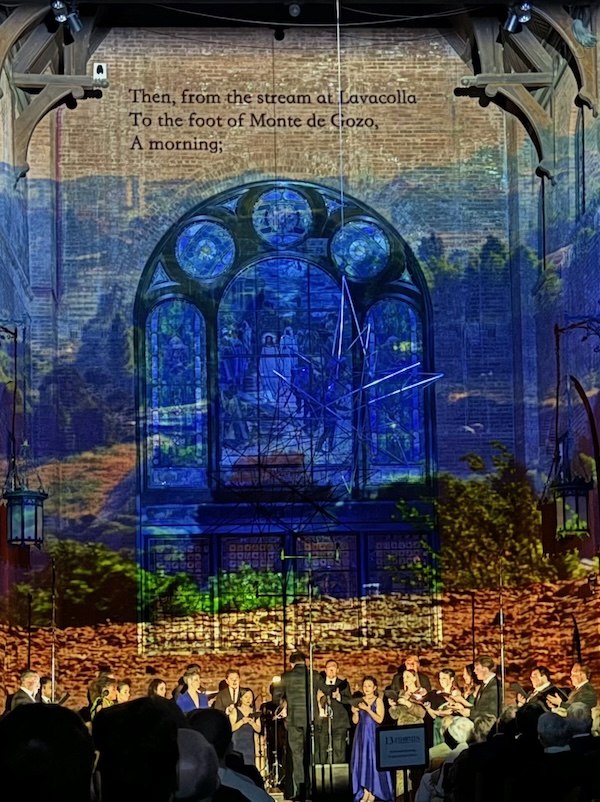The Thirteen’s “Path of Miracles” proves a feast for the eyes as much as the ears

Matthew Roberson led The Thirteen in Joby Talbot’s Path of Miracles Saturday night at St. Mark’s Episcopal Church. Photo: Camilla Tassi
Conductor Matthew Robertson routinely makes virtuosic demands of his elite chamber choir, The Thirteen. In their latest program, the ensemble gave the local debut of Joby Talbot’s semi-staged oratorio Path of Miracles. Heard at the second performance, Saturday night at St. Mark’s Episcopal Church on Capitol Hill, this daunting 65-minute work showed the group’s 21 singers, a mixture of professionals and this year’s vocal fellows, in an optimal light.
The chamber choir Tenebrae commissioned the work from the British composer in 2005. That group performed each of its four sections in four locations along the Spanish portion of the Camino de Santiago. The music evokes the physical and spiritual experiences of those walking on the pilgrimage to the shrine of the apostle St. James the Great in Compostela. For concert performances like this one, Talbot included optional stage directions for the singers.
The first movement, “Roncesvalles,” is named for the village by the mountain pass through the Pyrenees, where Charlemagne’s army was attacked in the Chanson de Roland, the first stop in Spain for many pilgrims. Talbot has written of the inspiration for the opening music, a “vocal ritual enacted by the aboriginal Bunun tribe of Taiwan” that he heard on the radio as a teenager, involving glissandi upwards from very low notes to a perfect fifth that moves higher and higher.
This music began at the rear of the church with the male singers, who gradually moved to the performance space at the end of the darkened nave and formed a circle. Overtones emerged as the knot of voices tightened and loosened, forming harmonies with themselves in the church’s resonant acoustic. Singers played the only instrumental parts indicated in Talbot’s score, occasional pinged notes from crotales, a set of small pitched cymbals.
At the climax of this rising tide of sound, the choir’s women joined from the back of the church, on open-fifth textures at extreme heights. Robertson coordinated this section expertly, with large gestures that could be seen by both groups. As the women began to process toward their colleagues under the church’s large stained glass window, countertenor Cody Bowers intoned the first of the work’s many solo lines with piercing resonance. A chant-like processional tune contrasted with the groaning glissandi, which returned at the end of the movement.
Women’s voices began the second movement, “Burgos,” with curious lines about thefts and murders along the Camino. The text, compiled by Robert Dickinson, includes words from the Bible, Spanish chants from the Codex Calixtinus and other sources, prayers, and references to the many traditions of the pilgrimage. It is a chaotic jumble of many languages, most of which remained untranslated in this performance.
Robertson’s careful conducting kept the ensemble on pace and in control over the work’s very long arc. Talbot relied extensively on slow, homophonic textures with relatively little variation beyond some chant-like monophony. Robertson helped his singers provide as much variety as they could through a broad dynamic range, from a whisper to a sacred howl. Exacting focus on balance and intonation yielded textures that could be felt resonating with the stone building, as in the octaves-spanning chords amassed in the third movement, “Burgos.”
The joyful arrival of the pilgrimage came across memorably in the last movement, “Santiago,” where a spring poem from the Carmina Burana codex inspired the most upbeat section of this rather austere piece. At the conclusion, the choir sang a repeating section of music as they recessed from the church one by one. Continuing to sing in the lobby, they faded gradually as the church darkened again.
Talbot is a prolific composer, with credits in film scoring and pop music: he has contributed lackluster scores for Christopher Wheeldon ballets with the National Ballet of Canada, including The Winter’s Tale and Alice in Wonderland. His operas have garnered greater praise including his first, Everest, and his most recent, The Diving Bell and the Butterfly, which was premiered by Dallas Opera in November.
Path of Miracles felt more profound in live performance, while it can sound empty and repetitive in recording, sort of like warmed-over Arvo Pärt, but ultimately one was left with the question of what exactly the piece was trying to say.
Where the ear might have been left wanting by the music, the eyes compensated in this performance, accompanied by church-encompassing projections designed by Camilla Tassi. A field of stars, reflecting the origin of the name Compostela, melted in and out, punctuated by images of stained glass, manuscript illuminations, and limited English translations of the sung text. The impact of this absorbing light show added immeasurably to the effect of this concert.
The Thirteen will perform Bach’s Mass in B minor at National City Christian Church 7:30 p.m. March 16 and 17. thethirteenchoir.org
